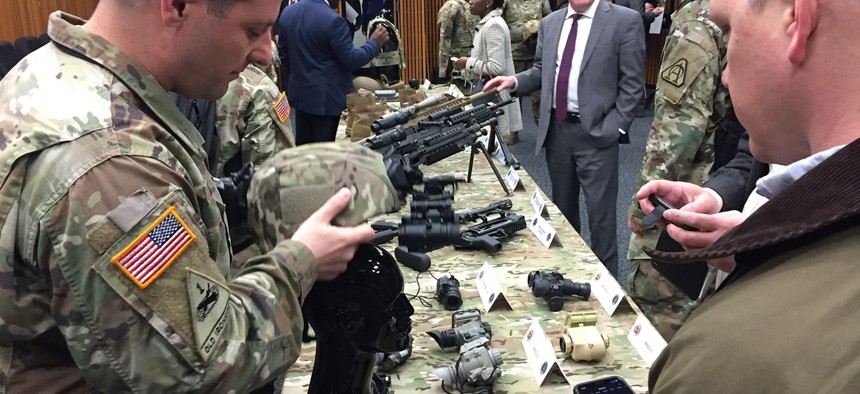
Army Capt. Josh Redmond of Program Executive Office Soldier shows off the new enhanced binocular night-vision goggles helmet during a demonstration at Fort Belvoir, Va., April 17, 2018. Jim Garamone/Department of Defense
Biden Nominees Want to Shake Up Pentagon Weapons Buying Process
Shyu, Blume tell Congress they plan to bridge the “valley of death” between the development phase and becoming a program of record.
The Pentagon’s budget process is not agile enough to quickly get emerging technology to soldiers on the battlefield, President Biden’s pick to oversee the Defense Department’s research and engineering efforts told Congress.
The largest roadblock, according to Heidi Shyu, is something known as the program objective memorandum, the Pentagon’s internal five-year spending plan more often called the POM. It typically takes two years at a minimum before funding for new projects can get put into the so-called POM. For context, budget planners inside the Pentagon are building the fiscal 2023 POM now.
“By the time you get the money to buy that technology, it's two years old now,” Shyu told the Senate Armed Services Committee during her confirmation hearing Tuesday to be defense undersecretary for research and engineering. “So there's absolutely a gap in terms of our ability to buy the latest technology.”
The POM is part of the Planning, Programming, Budgeting and Execution (PPBE) Process, which dates back to the early 1960s when Robert McNamera was President Kennedy’s defense secretary.
“It was a model that was appropriate for the industrial age, but we're in a post-Industrial Age,” Senate Armed Services Committee Chairman Jack Reed, D-R.I., said of the PPBE process.
New, cutting-edge technology, especially when developed by small companies, has trouble passing through the so-called “valley of death,” the phase between development and becoming a program of record.
“If confirmed, I would love to be able to work internally within the department with the services and come back to Congress with some ideas how we can bridge this valley of death,” Shyu said.
Speaking at the same hearing, Susanna Blume, who is nominated to be director of the Pentagon’s Cost Assessment and Program Evaluation office, said that if confirmed she will “look to make adjustments to the existing process, both things that the department can do on its own, and things that the department and the Congress would need to work on together to improve the agility of the process to overcome the valley of death.”
Shyu, who oversaw Army acquisition during the Obama administration, also said she would look to shift the Pentagon’s research initiatives so they don’t duplicate efforts already under way in the private sector. She also said she wants to find a way to reduce the amount of money the Pentagon spends on the lifetime costs of its weapons.
“Today, sustainment makes up 70% of a total weapon system’s cost, with development [and] procurement making up only 30%,” Shyu said “DOD should strive to flip this ratio and invest more in the development of new technologies than it does in the sustainment of legacy systems.”
As for her top areas of investment, Shyu said she wants to focus on artificial intelligence, hypersonics and synthetic biology. She also wants to “create networks, systems of systems that collect and share information securely, and [that] are robust against cyber and electronic warfare threats.”
Her other areas of focus, if confirmed, are reducing the military’s logistics footprint “by developing advanced materials, and increasing fuel efficiency.”





